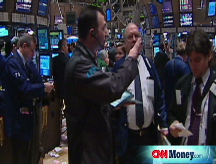Credit market less jittery
Key lending rates continue to decline as banks warm to government efforts. Federal Reserve announces new buying facility.
NEW YORK (CNNMoney.com) -- Bank lending rates continued to ease Tuesday as government efforts to stabilize the financial system appear to be encouraging some lenders to offer less stringent terms.
What remains to be seen is how quickly the more attractive terms will translate into increased money flow.
Global economic uncertainty has made banks wary of lending and constrained the flow of capital in the financial system. But a reading of the credit market's vital signs shows slow but steady improvement.
Governments worldwide have taken aggressive steps to restore confidence in the system by making more money available to financial institutions - and it's working.
Credit thaw: The closely watched overnight Libor rate fell to 1.28% from 1.51% Monday, according to Bloomberg.com. The key inter-bank lending rate is now below the Federal Reserve's benchmark interest rate, which stands at 1.5%, suggesting some stabilizing.
Libor is a daily average of what 16 different banks charge other banks to lend money in London and is used to calculate adjustable rate mortgages. The higher the rate, the tougher it could be for homeowners to pay those mortgages.
Overnight Libor soared to a high of 6.88% earlier this month after the government's $700 billion bailout bill was signed into law.
Longer-term lending also loosened, though it remains at elevated levels. The 3-month Libor fell to 3.83% from 4.06% Monday, according to Bloomberg.com. Last week, the 3-month Libor surged to 4.82% - the highest since mid-December 2007. A month ago, the rate was under 3%.
Meanwhile, a key measure of investors' appetite for risk indicated that confidence is slowly returning in the market.
The "TED spread" declined to 2.61 percentage points from 2.97 points Monday. This spread measures the difference between the 3-month Libor and the 3-month Treasury bill.
A wider spread means the market has less appetite for risky business. The spread had reached a record high of 4.65 points a little more than a week ago.
Latest Fed move: Federal Reserve officials on Tuesday unveiled the Money Market Investor Funding Facility (MMIFF), which gives the Fed authority to buy certain assets that money market funds have had difficulty selling in the current environment.
The new facility is "another way to enhance liquidity," said Bob Brusca, an economist at Fact and Opinion Economics in New York.
Money market funds, which often cater to individual or "retail" investors, are major investors in the market for short-term business loans called commercial paper.
As economic conditions grew worse, money market funds were faced with increased redemptions as nervous investors asked for their money back. That caused the commercial paper market to seize up, hindering businesses' ability to fund daily activities, and potentially making it difficult for money market funds to sell the assets necessary to meet redemptions.
"If money market funds have redemption requests and they can't sell assets, then you have panic...and it's panic over nothing," Brusca said.
With its latest action, the Fed could help restore confidence in the commercial paper market by providing a "buyer of first resort," Brusca said. "Just knowing that the Fed is there as a buyer, funds may be more willing to buy assets when they are there."
Talk of a second stimulus package is also lending confidence to the credit markets. Just the possibility that additional economic aid is being discussed could give banks more incentive to lend.
Treasurys: U.S. government debt prices were higher Tuesday as falling stock prices prompted investors to seek more stable returns in fixed-income investments.
The benchmark 10-year note rose 1-2/32 to 102 10/32 and its yield fell to 3.71% from 3.83% on Monday. Bond prices and yields move in opposite directions.
The 30-year long bond rose 31/32 to 105 2/32 and its yield fell to 4.197% from 4.24%.
And the two-year note added roughly 6/32 to 100 24/32 yielding 1.59%.
The yield on the 3-month bill was 1.1% after rising to 1.98% on Monday.
The yield on the 3-month Treasury bill is closely watched gauge of investor confidence. Money-market funds move money in and out of the 3-month bill frequently, depending on the level of risk in the broader market. A higher yield indicates that investors are slightly more optimistic. ![]()




